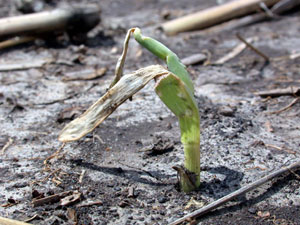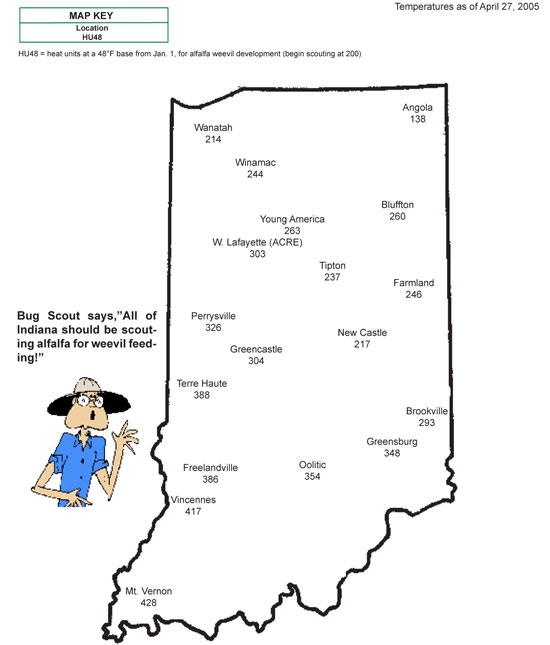Pest & Crop Newsletter, Entomology Extension, Purdue University
Corn Flea Beetle or Frost Damage? – (John Obermeyer, Christian Krupke, and Larry Bledsoe)
- Severe corn flea beetle feeding damage may be confused with frost damage.
- Most corn will outgrow flea beetle damage.
- Yellow dent corn under environmental stress with 5 or more beetles per plant may need treating.
- Seed, sweet, and popcorn are highly susceptible to Stewart's disease and require protection from feeding.

Corn flea beetle severe feeding.
The past weekend’s cold temperatures left some of Indiana’s corn damaged by frost. Corn flea beetle, active early in the spring, has been reported feeding in some emerging cornfields in the state. This tiny (1/16”), shiny black beetle feeds on corn leaves by stripping off the top layer of plant tissue. Their feeding etches the leaf surface, appearing as lines or “tracks.” Heavily infested plants may appear gray as their leaves shrivel and die, often confused with frost damage.
Emerged corn, especially in southern Indiana where more beetles are expected (see Pest&Crop #3) should be scouted for flea beetles and their damage. When cooler temperatures set in while corn is just emerging, (as they have this week) corn flea beetle may cause significant damage to corn. As the beetle continues to feed, the plant must rely on underground carbohydrates (i.e., the seed) until enough green leaf tissue is able to manufacture its own. Sustained beetle feeding during slow growth can stunt and/or kill the seedling.
On seedling dent corn, control may be necessary if the following conditions are met:
- 50% of the plants inspected show severe corn flea beetle feeding damage (plants begin to look silvery or whitish, or leaves begin to die),
- approximately 5 or more corn flea beetle per plant are found,
- poor growing conditions are causing slow corn growth (e.g., cool temperatures, dry soils, herbicide damage).

Frost damaged corn.
Normally, once a corn plant reaches the growth stage V5, it is no longer susceptible to significant corn flea beetle damage. Therefore, sampling for corn flea beetle typically will not be necessary once the plants have 5 leaves.
Corn flea beetle may also transmit the bacterium that causes Stewart’s wilt as it feeds. This can be a serious problem, especially on sweetcorn and seed corn inbreds. In sweetcorn, the disease may result in ears that are smaller than normal, or some infected plants may die. In seed production fields, severe leaf blight may cause lightweight, chaffy ears and increase the likelihood of stalk rots. The beetles alone are seldom severe enough to kill plants although in combination with the disease, they may. In seed production fields where highly susceptible inbreds are planted, treatment is probably justified if corn flea beetles are noted.
![]()
Black Cutworm Moth Flight Has Been Low This Spring – (John Obermeyer)
So far this season, the black cutworm moth migration into the Midwest has been low. This may be good news for the corn already planted, however continual moth flights into the state may be timed to cause damage in yet planted/emerged cornfields. We still await our first intense capture to be reported by the pheromone trap cooperators distributed throughout the state. Again, a big thanks for their efforts!
![]()
Bean Leaf Beetle Waking Up from Winter’s Nap - (John Obermeyer, Christian Krupke, and Larry Bledsoe)
- Early emerging soybean should be scouted for bean leaf beetle.
- Cotyledons and young leaves are prive feeding targets.
- Use treatment thresholds to make control decisions.
A small percentage of soybean fields have been planted and are beginning to emerge. Emerging plants in these fields may serve as “trap crops” for bean leaf beetles. Beetles that overwintered successfully are seeking both wild and cultivated legumes to feed on.
One of the most critical times for soybean damage is from emergence through the establishment of the first trifoliolate. If cotyledons are being destroyed before the unifoliolate leaves fully emerge or if the growing point is severely damaged, reduced yields are likely. However, once trifoliolate leaves have unrolled, soybean can tolerate up to about 40% defoliation without yield loss.
Control Cost, $/acre |
|||||
| Crop Value ($/bu) | 6.00 | 8.00 | 10.00 | 12.00 | 16.00 |
Beetles per plant |
|||||
| 5.00 | 3 | 4 | 5 | 6 | 8 |
| 6.00 | 3 | 4 | 5 | 5 | 7 |
| * Table modified from the University of Nebraska | |||||
For cotyledon- and unifoliolate-stage soybean, refer to the following threshold values:*
![]()
Click for Table.
Black Cutworm Adult Pheromone Trap Report.
Click for Table.
Black Light Catch Report.
![]()
Cold Weather and Postemergence, Spike Stage Herbicide Applications in Corn – (Bill Johnson)
We have observed quite a bit of corn emerging over the last couple of days. It is likely that recent windy, then rainy conditions prohibited many fields from receiving soil applied herbicides. Since almost all soil applied chloroacetamide:atrazine premix products can be applied to emerged corn, it will be tempting to spray these fields as soon as they are dry enough to drive across. Here are a few important points to keep in mind.
- Cool, cloudy weather and wet soils slow the corn plants ability to metabolize (detoxify) herbicides. Corn will be stressed after coming through the cool, wet period and will be more susceptible to showing herbicide injury symptoms. This is a typical condition under which we see atrazine injury and chloroacetamide injury.
- As a general rule, do not apply chloroacetamide:atrazine premixes in nitrogen solutions if the corn is emerged. Nitrogen solutions are effective in promoting herbicide uptake and causing necrosis on leaves by themselves, resulting in severe injury. Most labels state that atrazine premixes should only be applied in water if the corn has emerged. A few products do allow postemergence applications in nitrogen solutions, but consult the label if you have questions about a specific product.
- Another general consideration involves tank mixtures of 2,4-D with a chloroacetamide:atrazine premix and applying this mixture to emerged corn. The acetochlor (Harness, Degree, Keystone) labels indicate that 2,4-D should not be applied within 7-14 days before or 3-5 days after planting, but before crop emergence. This restriction is written into to the label because of crop injury concerns. Applications within 7-14 days before planting can injure corn by being washed down into the corn seed germination zone (seed furrow). Applications after corn planting can cause injury if the combination of products comes into contact with corn foliage. If in doubt about crop injury potential of a specific chloroacetamide:atrazine premix, consult the label to see if it is allowed or do not tankmix 2,4-D with atrazine premixes and apply to emerged corn.
- If the field has a dense infestation of emerged weeds and an aggressive adjuvant system will be needed to increase postemergence herbicide activity, wait a few days to allow the corn to recover from the cold stress before applying herbicides.
![]()
Did We Dodge a Frozen Corn Bullet? – (Bob Nielsen)
?From what I can tell looking at temperature reports around Indiana this past weekend and looking at some fields of emerged corn, I don’t believe Sunday morning’s low temperatures around the state were lethal for corn that was planted and/or emerged. Cloud cover helped us avoid frost also, so we dodged that “bullet” also. Emerged corn at the Purdue Agronomy Farm showed some evidence of injury Monday. Some fields in far northern and/or eastern Indiana may have experienced some snow cover Saturday night and Sunday, but that will not necessarily be lethal to an emerged corn crop either.
Isolated frost forecast for Monday morning (Apr 25) may damage aboveground leaves of emerged plants. The forecasted temperatures in the low to mid 30’s, however, should again NOT be lethal to growing points.
Bottom line is that I doubt that replanting will be necessary for much, if any, of the early planted corn in Indiana. Growers concerned about such a decision should exercise patience and give damaged fields three to five days to show evidence of recovery from frost/freeze damage.
Growers should be aware that emerged corn over the next few days will likely take on the typical “crappy” yellow-green appearance associated with exposure to such cold snaps. A return to warm sunny weather will help alleviate this ugly state. Of more concern is a bit of fear mongering about the possibility that some planted fields not yet emerged may experience some degree of twisted or corkscrewed mesocotyls leading to belowground leaf emergence and stand loss. This phenomenon is anecdotally attributed to unusually cold soils prior to emergence.
Stay tuned for more information......
For other Corny News Network articles, browse through the CNN Archives at www.kingcorn.org/news/archive.html.
For other information about corn, take a look at the Corn Growers’ Guidebook at www.kingcorn.org.
![]()


